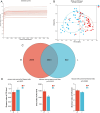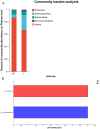Increased maternal exercise of moderate intensity improves pregnancy outcomes of gestational diabetes mellitus patients through maintaining the balance of the gut microbiota
- PMID: 40510669
- PMCID: PMC12158928
- DOI: 10.3389/fmicb.2025.1526714
Increased maternal exercise of moderate intensity improves pregnancy outcomes of gestational diabetes mellitus patients through maintaining the balance of the gut microbiota
Abstract
Background: Exercise therapy can reduce insulin resistance during pregnancy and improve glucose tolerance in women with gestational diabetes mellitus (GDM), leading to better pregnancy outcomes. This study aimed to investigate the effects of different exercise levels on GDM from the perspective of gut microbiota.
Methods: Ninety patients with GDM were enrolled and divided into two groups: the L (n = 50) and the M (n = 40) groups. The L group performed 150 min of aerobic exercise per week, while the M group exercised for 200 min per week. After 8 weeks of intervention, fecal samples from each subject were collected for 16S rRNA gene sequencing.
Results: Different exercise levels significantly affected membrane rupture and gestational weight gain in GDM patients (p < 0.05), but these effects were not significantly correlated by logistic regression analysis (p > 0.05). After sequencing, 4,712 OTUs and 3,483 OTUs were identified in the M and L groups, respectively, with 2,643 OTUs overlapping between both groups. Compared to the L group, the α-diversity in the M group was significantly increased (p < 0.05). The dominant phyla were Firmicutes, Actinobacteriota, and Bacteroidota. Compared to the L group, the M group had a significantly higher abundance of Firmicutes and a significantly lower abundance of Actinobacteriota. At the genus level, LEfSe analysis revealed that moderate-intensity exercise increased the levels of Faecalibacterium, Agathobacter, Roseburia, and Osillospira, but decreased the abundance of Bifidobacterium and Coprobacillus.
Conclusion: There were significant differences in the composition and structure of the gut microbiota of patients with GDM with different exercise levels.
Keywords: Faecalibacterium; biodiversity; exercise; gestational diabetes mellitus; gut microbiota.
Copyright © 2025 Xu, Ye, Cai and Wu.
Conflict of interest statement
The authors declare that the research was conducted in the absence of any commercial or financial relationships that could be construed as a potential conflict of interest.
Figures



Similar articles
-
Gestational diabetes is associated with change in the gut microbiota composition in third trimester of pregnancy and postpartum.Microbiome. 2018 May 15;6(1):89. doi: 10.1186/s40168-018-0472-x. Microbiome. 2018. PMID: 29764499 Free PMC article.
-
[Effects of gestational diabetes mellitus on gut microbiota of 3-month-old infants: a prospective control study].Wei Sheng Yan Jiu. 2022 Nov;51(6):934-939. doi: 10.19813/j.cnki.weishengyanjiu.2022.06.013. Wei Sheng Yan Jiu. 2022. PMID: 36539872 Chinese.
-
Composition of the intestinal microbiota and its variations between the second and third trimesters in women with gestational diabetes mellitus and without gestational diabetes mellitus.Front Endocrinol (Lausanne). 2023 Jul 14;14:1126572. doi: 10.3389/fendo.2023.1126572. eCollection 2023. Front Endocrinol (Lausanne). 2023. PMID: 37522117 Free PMC article.
-
Mechanismbased role of the intestinal microbiota in gestational diabetes mellitus: A systematic review and meta-analysis.Front Immunol. 2023 Mar 3;13:1097853. doi: 10.3389/fimmu.2022.1097853. eCollection 2022. Front Immunol. 2023. PMID: 36936475 Free PMC article.
-
Relationship between gut microbiota and the pathogenesis of gestational diabetes mellitus: a systematic review.Front Cell Infect Microbiol. 2024 May 28;14:1364545. doi: 10.3389/fcimb.2024.1364545. eCollection 2024. Front Cell Infect Microbiol. 2024. PMID: 38868299 Free PMC article.
References
-
- Ai-Sadi H. L., Al-Haili T., Alshukri A., Alghazali T., Sabti A. A., Jasim S. A. (2022). Effects of a continuous and periodic aerobic exercise rehabilitation program on depression and anxiety in hypertension patients. Int. J. Body Mind Cult. 9, 323–334. doi: 10.22122/ijbmc.v9i4.404 - DOI
-
- Allen J. M., Berg Miller M. E., Pence B. D., Whitlock K., Nehra V., Gaskins H. R., et al. (1985). Voluntary and forced exercise differentially alters the gut microbiome in C57BL/6J mice. J. Appl. Physiol. 118, 1059–1066. - PubMed
LinkOut - more resources
Full Text Sources

